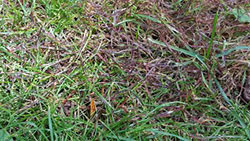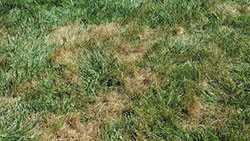Adapted by Eric Hammond, Adams County Extension, from the CO-Horts blog originally authored by Tony Koski, CSU Extension Turf Specialist
Is roughstalk bluegrass good for lawns?

Rough(stalk) bluegrass (Poa trivialis) is a cool season relative of Kentucky bluegrass. The grass is an undesirable one commonly found in home lawns. Rough(stalk) bluegrass becomes noticeable in the summer when it will turn purple or red under heat-and/or drought-stress, and then brown when completely dormant. Rough bluegrass turns brown when completely dormant. While it looks dead, it will revive itself when cooler weather returns in the fall. It spreads easily and quickly by creeping stolons (runners) to form large patches – especially in lawns that are kept on the wet side. Shade favors its growth, but it can grow quite well in full-sun (but is more likely to go dormant in the sunnier parts of lawns). It is an aggressive, smothering grass under optimal conditions (wet, cool, shady), but less aggressive in drier, sunnier lawns.
Can roughstalk bluegrass survive heat?

Rough(stalk) bluegrass will often go dormant when it’s hot, in spite of generous irrigation. It’s not a drought-induced dormancy, but rather a heat-induced one. Often patches can be seen in shady spots and when conditions are right it will aggressively crowd out original (more desirable) turf types such as Kentucky bluegrass, ryegrass, fine fescues, tall fescues etc.
How can I control roughstalk?
Unfortunately there is no selective herbicide that will eliminate this weedy grass without harming the bluegrass or ryegrass in the lawn. Therefore homeowners must decide whether to live with the infestation or kill and re-seed or re-sod the entire lawn.
For more information on renovating a home lawn see the CSU Extension Fact Sheet:



